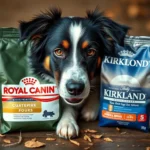
Proper nutrition is crucial for our furry friends, as it directly impacts their health, behavior, and overall well-being. As pet owners, we often find ourselves curious about sharing our human foods with our dogs. One common question that arises is: can dogs eat bread? In this article, we will explore the implications of including bread in your dog’s diet, as well as provide a detailed understanding of canine nutrition and safe practices for feeding dogs human food.
Understanding Canine Nutrition
Essential Nutrients for Dogs
Just like humans, dogs require a balance of essential nutrients to thrive. Their diet should include:
- Proteins: The building blocks for muscles and tissues. Essential for growth and repair.
- Fats: A crucial energy source that also supports skin and coat health.
- Carbohydrates: Provide energy and aid in digestion, although dogs do not require carbohydrates as strictly as humans do.
- Vitamins and Minerals: Vital for various bodily functions, including immune response and bone health.
Different life stages demand different nutritional needs. Puppies require higher protein and calorie intake for growth, while senior dogs may need lower calories to prevent obesity.
Common Dietary Issues in Dogs
Dogs can face various dietary challenges, including:
- Allergies and Intolerances: Some dogs may be allergic to common ingredients like wheat or certain proteins.
- Obesity: Often caused by overfeeding or lack of exercise, leading to health complications.
- Digestive Problems: Signs such as vomiting or diarrhea may indicate dietary issues, necessitating a veterinarian’s advice.
Consulting a veterinarian about your dog’s nutritional needs can prevent these issues and ensure a balanced diet tailored to their specific requirements.
Bread as a Human Food
Nutritional Profile of Bread
Bread is a staple food in many households, but its nutritional value can vary significantly among different types. Here are some common types of bread and their nutritional considerations:
- White Bread: Often made from refined flour, it has lower nutritional value and higher glycemic index.
- Whole Wheat Bread: Offers more fiber and nutrients due to less processing.
- Gluten-Free Bread: Made for those with gluten sensitivities; nutritional content varies widely.
Pros and Cons:
– Pros: When made without harmful additives, bread can provide carbohydrates and some vitamins.
– Cons: Many commercial breads contain preservatives, sugars, and unhealthy fats.
Types of Bread Safe for Dogs
If you’re wondering whether can dogs eat bread, the answer is yes, but with caution. The following types of bread are generally considered safe for dogs:
- Plain White Bread: In moderation, this can be a simple treat.
- Whole Grain Bread: Offers more nutrients and fiber.
However, it’s crucial to avoid any bread containing harmful ingredients such as:
- Raisins: Can cause kidney failure in dogs.
- Garlic and Onions: These can be toxic to dogs, leading to gastrointestinal upset and more severe health issues.
Can Dogs Eat Bread?
Benefits of Feeding Bread to Dogs
Bread can offer some benefits when incorporated appropriately into a dog’s diet:
- Source of Carbohydrates: Provides energy, particularly for active dogs.
- Occasional Treat: Bread can be a fun and tasty snack.
- Training Rewards: It can be used as a reward during training, making it easier to reinforce positive behavior.
Risks and Considerations
While there are benefits, there are also potential risks associated with feeding bread to dogs:
- Obesity: Excessive consumption can lead to weight gain, especially in less active dogs.
- Digestive Issues: Some dogs may have difficulty digesting bread, leading to bloating or discomfort.
- Portion Control: It’s essential to limit bread to avoid overfeeding.
Watch for common signs of bread intolerance, such as:
- Vomiting
- Diarrhea
- Lethargy
- Abdominal pain
If you notice these symptoms, it’s advisable to consult a veterinarian.
How to Incorporate Bread into Your Dog’s Diet
Serving Suggestions
When deciding to share bread with your dog, consider these serving suggestions:
- Toasted Bread: A small piece of toasted bread can be a crunchy treat.
- With Peanut Butter: Spread a small amount of dog-safe peanut butter on whole grain bread for a delicious snack.
As a general guideline, keep serving sizes small and appropriate for your dog’s size and weight. For example:
- Small Dogs: Limit to a quarter of a slice.
- Medium Dogs: Up to half a slice.
- Large Dogs: A full slice may be acceptable, but monitor their response.
Homemade Bread Recipes for Dogs
For pet owners who prefer a more controlled approach, making homemade dog-friendly bread is a great option. Here’s a simple recipe to get you started:
Peanut Butter and Pumpkin Bread
Ingredients:
– 1 cup whole wheat flour
– 1/2 cup pumpkin puree (unsweetened)
– 1/4 cup natural peanut butter (xylitol-free)
– 1/4 cup water
– 1 egg
Instructions:
1. Preheat the oven to 350°F (175°C).
2. In a bowl, mix all ingredients until you form a dough.
3. Roll out and cut into shapes or place in a greased loaf pan.
4. Bake for 20-25 minutes, or until golden brown.
5. Let cool before serving.
This bread is a great way to treat your dog without the preservatives and additives found in store-bought options.
Alternatives to Bread for Dogs
Healthier Treat Options
While bread can be an occasional treat, there are healthier alternatives that are often better for your dog:
- Fruits: Apples (without seeds), blueberries, and bananas can be great snacks.
- Vegetables: Carrots, green beans, and sweet potatoes are nutritious and low-calorie.
- Specialized Dog Treats: Many commercial dog treats are formulated to be nutritious and safe.
These alternatives can provide the benefits of treats without the risks associated with feeding bread.
When to Consult a Vet
Recognizing when to seek professional advice regarding your dog’s diet is essential. Signs that may indicate the need for veterinary consultation include:
- Sudden changes in appetite or weight.
- Persistent digestive issues.
- Allergic reactions (itching, swelling).
Regular veterinary check-ups can help ensure your dog maintains a balanced diet and remains healthy.
Conclusion
In summary, the question of can dogs eat bread can be answered affirmatively, but with considerations for moderation and safety. It’s crucial to understand the nutritional needs of your dog and the potential risks associated with feeding them human food. Always opt for plain or whole grain bread without harmful ingredients, and consult your veterinarian for personalized dietary advice.
Being mindful of your dog’s dietary needs will help promote their overall health and happiness. Whether you choose to incorporate bread or opt for healthier alternatives, a balanced diet is the key to a long and fulfilling life for your beloved pet.









